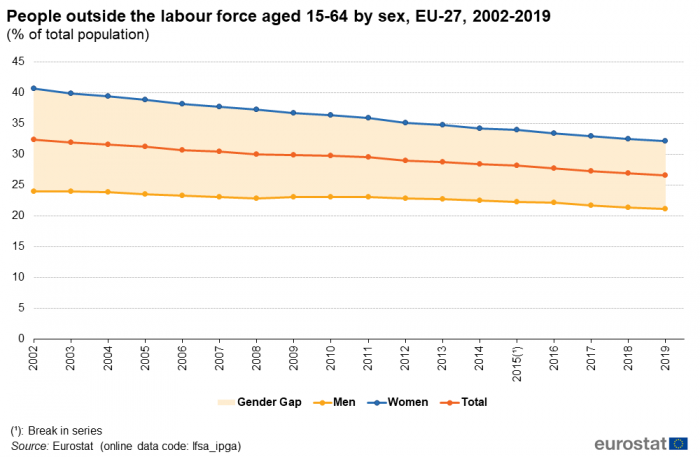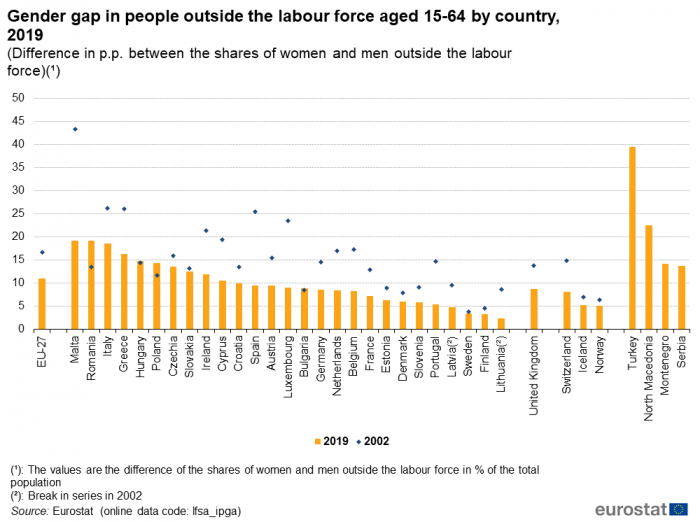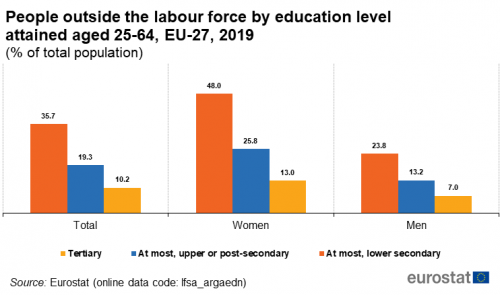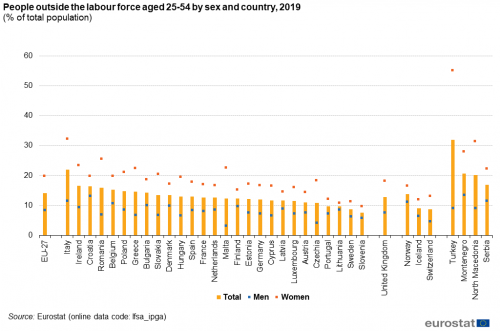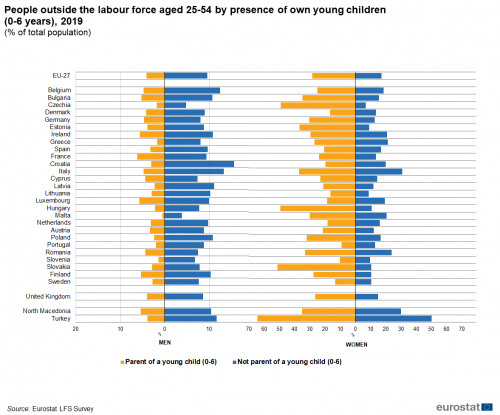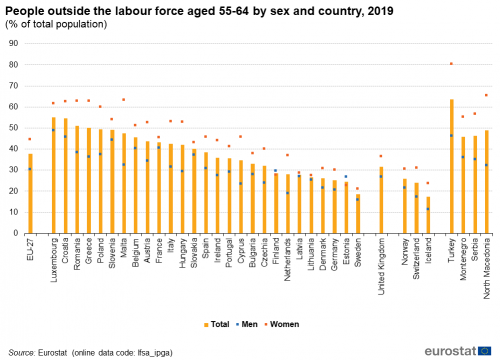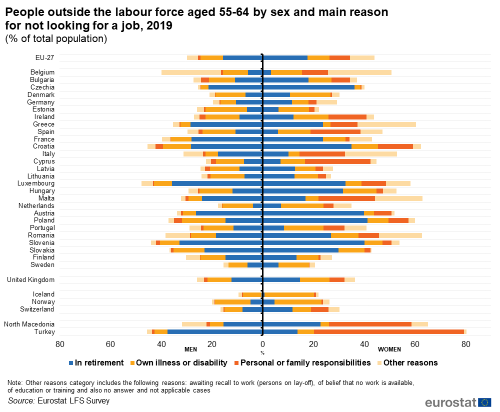Archive:People outside the labour force
Data extracted in May 2020.
Planned article update: 22 June 2021.
Highlights
People outside the labour force aged 15-64 by sex, EU-27, 2002-2019
The population of people outside the labour force is a heterogeneous group, e.g. as regards sex, age, reasons for not looking for a job and level of attachment to the labour force. The following article, using the results of the Labour Force Survey (EU-LFS), aims at characterizing this group in the European Union (EU) as a whole, as well as in the different countries.
Full article
More people outside the labour force in 2020
This statistical article looks at the population outside the labour force, i.e. the population that is neither employed nor unemployed. The share of people outside the labour force in the total population of working age<ref> has fallen from 32.3 % in 2002 to 26.6 % in 2019 in the EU, marking 17 consecutive years of a decrease. Hereafter in 2020, this share increased to 27.1 %, corresponding to 1.3 million more people outside the labour force since 2019.
The decrease in people outside the labour force is mainly explained by the rising participation of women in the labour force. The share of women outside the labour force fell by 8.5 percentage points (p.p.), during 2002-2019 from 40.6 % to 32.1 %, while the share of men outside the labour force decreased by only 2.8 p.p. (from 23.9 % in 2002 to 21.1 % in 2019). Consequently, the gender gap in the EU decreased continuously during this period of time, from 16.7 p.p. in 2002 to 11.0 p.p. in 2019.
The declining trend in the gender gap is visible in almost all EU Member States (see Figure 2). While 11 EU Member States had a gender gap above 15 p.p. in 2002, only 4 EU Member States exceed this gap in 2019: Romania and Malta (both 19.1 p.p.), Italy (18.5 p.p.) and Greece (16.3 p.p.). These countries except Malta were the ones where participation of women in the labour force was the lowest (respectively 56.5 %, 58.9 % and 60.4 % of women aged 15-64 were in the labour force in Italy, Romania and Greece in 2019). Nevertheless, the situation remains quite heterogeneous among countries. The gender gap was the lowest in Lithuania (2.3 p.p.), followed by Finland 3.3 p.p., Sweden 3.4 p.p., Latvia (4.8 p.p.) and Portugal (5.4 p.p.).
The number of people outside the labour force largely depends on sex, age and education level
The decreasing pattern in the number of people outside the labour force conceals contrasting situations depending on the age group (see Figure 3).
The situation for the youngest age group, i.e. people aged 15-24, has been quite stable in the last couple of years, even if the share of people outside the labour force in the age group 15-24 has been slightly increasing since 2002 for both women and men. More than half of men and women aged 15-24 are outside the labour force in the EU-27 all over the period 2002-2019. This high rate is explained by the fact that most people in this age group are still in education or training (see the article on Youth unemployment). Consequently, they are not available for work and/or do not actively seek work.
The population outside the labour force in the age group 55-64 has experienced the greatest decrease since 2002. The percentage of men outside the labour force aged 55-64 fell by 20.1 p.p. (from 50.5 % in 2002 to 30.4 % in 2019) and by 26.8 p.p. for women (from 71.4 % in 2002 to 44.6 % in 2019).
The category 25-54 is by far the largest of the three groups in terms of population, but it is also the age group experiencing the lowest rates of people outside the labour force. In this group, a small share of men are outside the labour force (8.4 % in 2019). This can be seen as a structural set of circumstances, as the ratio remains stable overtime and despite the economic situation (8.6 % in 2002). There are also fewer women aged 25-54 outside the labour force, compared to the other age groups, showing a continuously decreasing trend (ratio of 26.4 % in 2002 compared with 19.8 % in 2019), yet still high in comparison to men.
The consequence of very high numbers of people outside the labour force aged 15-24 and 55-64 is even more visible in absolute figures, with the number of people outside the labour force being similar in the three age groups despite the different population size. Indeed, in the EU-27 in 2019, the age group 15-24 encompassed 28.1 million people outside the labour force out of a total of 46.4 million people. In the age group 25-54, 25.2 million persons out of 179.0 million were outside the labour force. Finally, 22.5 million persons out of 59.6 million were outside the labour force in the age group 55-64.
Another determining factor of being outside the labour force is the educational level attained. People with a higher educational level are less likely to be outside the labour force. In 2019, for the whole EU-27, people outside the labour force in the age group 25-64[1] who had attained a low educational level (i.e. with at most lower secondary) was 35.7 %, as compared with 19.3 % for people with a medium educational level (i.e. at most upper secondary or post-secondary level, but less than tertiary) and 10.2 % for persons with a high (i.e. tertiary) level (see Figure 4). This relationship between educational attainment level and being outside the labour force applies irrespective of sex.
Young people mainly in education
Young people tend to be outside the labour force: in 2019 in the EU-27, 57.8 % of men and 63.6 % of women aged 15-24 were outside the labour force (corresponding to 60.7 % of people aged 15-24), with a total of 28.1 million persons. The rate of people outside the labour force in this age group ranges from 30.0 % in the Netherlands to 77.5 % in Greece, 76.1 % in Bulgaria and 73.9 % in Italy (see Figure 5). Differences between countries are largely explained by the number of young people combining studies and presence in the labour force (having or seeking a small side job)[2].
The incidence of and reasons for being outside the labour force for men and women in this age group do not reveal a lot of differences comparable to those observed in older age groups. Being in education is by far the most frequent reason that both sexes give for not looking for a job (54.6 % for women and 51.0 % for men in the EU-27 in 2019). The gender-related differences in this age group are on one hand that 3.1 % of total population of women report family responsibilities as their main reason for not looking for a job, while for young men this is extremely rarely the case (0.6 %) and on the other hand a bigger share of women is in education (54.6 %) compared to the men (51.0 %). Exceptionally, in Turkey 23.9 % of women outside the labour force report personal or family responsibilities as the main reason for not looking for a job (see Figure 6).
Family responsibilities is the main reason for women aged 25-54 for being outside the labour force
Regardless the gender, in 2019, the share of people outside the labour force aged 25-54 was higher than 15 % in Italy, Ireland, Croatia, Romania and Belgium, while it was below 10 % in Slovenia, Sweden, Lithuania and Portugal (see Figure 7).
The main working age in the EU is between 25 and 54 years. This is also the age when families are started and children are raised. It is in this age group that the gender differences for being outside the labour force are more pronounced. In 2019, 8.4 % of men in this age group were outside the labour force in the EU-27 compared with 19.8 % of total women. The percentage of men outside the labour force was the lowest in Malta (3.2 %) and in Czechia (4.1 %) and the highest in Croatia (13.1 %), Italy (11.5 %), Belgium (10.7 %) and Bulgaria (10.0 %). Women aged 25-54 that were outside the labour force ranged from 9.6 % in Slovenia, 10.8 % in Lithuania and 11.3 % in Sweden to 22.5 % in Malta, 23.3 % in Ireland, 25.4 % in Romania and 32.2 % in Italy. In the non-EU countries, Montenegro, North Macedonia and Turkey recorded high rates of women outside the labour force, 27.9 %, 31.4 % and 55.0 % respectively.
In the EU-27, almost half of women outside the labour force aged 25-54 were in this situation for personal or family reasons (49.4 % of women outside the labour force, corresponding to 9.8 % of all women aged 25-54), while only 7.6 % of men outside the labour force gave this as the main reason for not looking for a job (corresponding to 0.6 % of all men aged 25-54) (see Figure 8). It is important to note that the EU-LFS only collects the main reason although other reasons may exist.
The gender difference is much less significant for the other reasons than for "personal or family responsibilities": figures reported for the reasons "own illness or disability", "in education" and "retirement" are similar for men and women. For example, 3.2 % of all women aged 25-54 reported not looking for a job for "own illness or disability" reason while 3.1 % of men were in this situation. In total, 4.3 million men and 4.4 million women gave "own illness or disability", "in education" or "retirement" as main reason for not looking for a job (see Figure 9).
More women aged 25-54 are outside the labour force if they are mothers of young children aged 6 or under: 28.4 % compared with 17.0 % for women aged 25-54 without small children in the EU-27 in 2019. For men the opposite is found: if there is one or more young child in their household, the proportion of men outside the labour force was 4.1 %, compared to 9.6 % if no such child was present in the household. Those patterns, due to the presence of children, are evident in every country except for women in Portugal, Luxembourg and Croatia (see Figure 10).
30.4 % of men and 44.6 % of women aged 55-64 are outside the labour force
Amongst the EU Member States, Luxembourg, Croatia, Romania and Greece recorded the highest share of people outside the labour force , all above 50 % in the age group 55-64 in 2019. On the other hand, the five countries in the European Union with the lowest shares are Sweden with 18.5 % of people aged 55-64 being outside the labour force followed by Lithuania, Denmark, Germany and Estonia all four with a share lower than 27 % (see Figure 11).
When data is analysed by sex, it appears that nearly half of the women aged 55-64 are outside the labour force (44.6 %) in the EU-27 in 2019, which is the case for 30.4 % of men in the same age group.
Amongst EU Member States, the highest shares of men aged 55-64 outside the labour force were found in 2019 in Luxembourg (48.8 %) and Croatia (45.8 %) while the lowest were recorded in Sweden (15.9 %) and the Netherlands (19.0 %). The number of women outside the labour force was as high as 63.3 % in Malta, 62.7 % in Romania and Greece and 62.5 % in Croatia. The highest rates for women can nevertheless be found in North Macedonia (65.3 %) and in Turkey (80.4 %). On the other hand, the lowest rates for women were 21.1 % in Sweden and 22.6 % in Estonia. There was also a low share of people outside the labour force in Iceland: only 11.2 % of men and 23.7 % of women in this age group.
Retirement is the most frequent reason given by men in this age category for being outside the labour force; 15.6 % of the total male population in this age group was retired. The second most common reason was "own illness or disability", with 9.0 % of the male population in this age category not looking for a job for this reason (see Figure 12).
Retirement is also the most frequent specific reason for women in this age group, with 17.6 % of them giving this as the main reason in 2019. Own illness or disability (8.7 %) and personal or family responsibilities (8.0 %) are other non-negligible causes for being outside the labour force among women in the EU-27 in this age category. In contrast to men, however, the pattern for women is less consistent across the EU Member States. In some countries, personal or family responsibilities are the main reasons given in this age group for women outside the labour force, with retirement being the prevailing reason in other countries (see Figure 12).
75.3 % of people outside the labour force aged 25-54 have not worked during the last two years
The concept of people outside the labour force encompasses people with varying degrees of attachment to the labour force. This can be seen, for instance, by looking at their previous working experience, i.e. how many of them have previously worked, the duration of their work and how long ago they were last working.
Among the young population aged 15-24 who were outside the labour force in the EU-27 in 2019, the overwhelming majority (90.0 %) have never worked before; 8.5 % have worked during the last 2 years and 1.5 % last worked over 2 years ago. This means that most of these persons have not yet entered the labour force, and those who have done so retain some attachment in the form of a relatively recent previous job.
Among people outside the labour force in the prime working age group 25-54, the distribution shifts significantly: 24.7 % have worked in the last two years, 43.0 % last worked more than two years ago and 32.3 % have never worked. This shows a rather high degree of labour force detachment, as 75.3 % have not worked during the last 2 years.
Finally, among the population aged 55-64 who are outside the labour force, 22.2 % have worked in the last two years and 67.5 % have worked more than two years ago and only 10.3 % have never worked. This shows that, with age, most people were, at some point, part of the labour force, but for many the connection does not last.
18.4 % of the population outside the labour force are interested in working
People outside the labour force are defined by the fact that they do not have a job and are either not actively looking for a job or are not immediately available to work (or both), i.e. they are neither employed nor unemployed. Most of them, but not all, are not interested in working. Persons who are outside the labour force have a varying degree of attachment to the labour force, which can be analysed from the viewpoint of their behaviour with regard to the three interrelated main variables: Do they want to work? Are they actively seeking a job? Are they available to start immediately in a new job? For instance, some people who are not available to work do not even consider whether they want to work (this is the case for many students). Instead, for other jobless persons, the lack of immediate availability is not an impediment to seeking a job, which indicates a much stronger attachment to the labour force. Similar percentages of people outside the labour force that are interested in working are observed for people aged 15-24 and 55-64, i.e. 11.8 % and 10.2 % respectively while this share is much higher for people aged 25-54 (33.1 %) (see Figure 14).
Source data for tables and graphs
Data sources
Source: All statistics presented in this article are derived from the European Union Labour Force Survey (EU-LFS). The EU-LFS is the largest European household sample survey providing quarterly and annual results on labour participation of people aged 15 and over as well as on persons outside the labour force. It covers residents in private households. Conscripts in military or community service are not included in the results. The EU-LFS is based on the same target populations and uses the same definitions in all countries, which means that the results are comparable between the countries.
Reference period: Yearly results are obtained as averages of the four quarters in the year. However, data on reason for being outside the labour force is annual, this variable not being collected on a quarterly basis.
Coverage: The results from the survey currently cover all European Union Member States, the United Kingdom, the EFTA Member States of Iceland, Norway, Switzerland, as well as the candidate countries Montenegro, North Macedonia, Serbia and Turkey. For Cyprus, the survey covers only the areas of Cyprus controlled by the Government of the Republic of Cyprus.
European aggregates: EU refers to the sum of EU-27 Member States. If data are unavailable for a country, the calculation of the corresponding aggregates takes into account the data for the same country for the most recent period available. Such cases are indicated.
Definitions: The concepts and definitions used in the survey follow the guidelines of the International Labour Organization (ILO):
- People outside the labour force are those who are neither employed nor unemployed.
- Employed people comprise:
(a) persons who during the reference week worked for at least one hour for pay or profit or family gain; (b) persons who were not at work during the reference week but had a job or business from which they were temporarily absent.
- Unemployed people comprise persons who were:
(1) not employed according to the definition of employment above; (2) currently available for work, i.e. were available for paid employment or self-employment before the end of the two weeks following the reference week; (3) actively seeking work, i.e. had taken specific steps in the four week period ending with the reference week to seek paid employment or self-employment or who found a job to start later, i.e. within a period of at most three months from the end of the reference week.
- Reason for being outside the labour force is the main reason why somebody is not searching for employment. The main reason may or may not be the only reason. Only the main one is retained for analysis in this article.
- Level of education is defined according to the International standard classification of education, version 2011 (ISCED 2011). Eurostat’s online tables and databases present data on educational attainment for three aggregates (low, medium and high levels of education).
Context
Council Decision 2010/707/EU of 21 October 2010 on guidelines for the employment policies of the EU Member States demands that policies be put in place to increase the labour market participation of women and men, and to promote labour market participation for those furthest away from the labour market.
More recently, the European Pillar of Social Rights has been jointly signed by the European Parliament, the Council and the Commission on 17 November 2017. Employment and social policies are the main fields of interest of the European Pillar of Social Rights, which is about delivering new and more effective rights for citizens. It has 3 main categories: (1) Equal opportunities and access to the labour market, (2) Fair working conditions and (3) Social protection and inclusion. In particular, today's more flexible working arrangements provide new job opportunities especially for the young but can potentially give rise to new precariousness and inequalities. Building a fairer Europe and strengthening its social dimension is a key priority for the Commission. The European Pillar of Social Rights is accompanied by a ‘social scoreboard’ which will monitor the implementation of the Pillar by tracking trends and performances across EU countries in 12 areas and will feed into the European Semester of economic policy coordination. The scoreboard will also serve to assess progress towards a social ‘triple A’ for the EU as a whole.
Although labour market economists tend to focus on the activities and characteristics of people in the labour force, there has been continued, if less visible, interest in individuals outside of the labour market, especially those who want to work but are not currently seeking work. Much of this growing interest stems from concern over improving the availability of decent and productive employment opportunities in developing and developed economies alike. Individuals are considered to be outside the labour force, if they are neither employed nor unemployed, that is, not actively seeking work. There is a variety of reasons why some individuals do not participate in the labour force; such persons may be occupied in caring for family members; they may be retired, sick or disabled or attending school; they may believe no jobs are available; or they may simply not want to work.
Direct access to
- LFS main indicators (t_lfsi)
- LFS series - Detailed annual survey results (t_lfsa)
- LFS main indicators (lfsi)
- LFS series - Detailed annual survey results (lfsa)
- Commission Regulation (EC) No 377/2008 of 25 April 2008 on the organisation of a labour force sample survey in the Community as regards the codification to be used for data transmission from 2009 onwards, the use of a sub-sample for the collection of data on structural variables and the definition of the reference quarters
- Commission Regulation (EC) No 1897/2000 of 7 September 2000 implementing Council Regulation (EC) No 577/98 on the organisation of a labour force sample survey in the Community concerning the operational definition of unemployment
- Council Regulation (EC) No 577/98 of 9 March 1998 on the organisation of a labour force sample survey in the Community (Summary)
- Regulation (EC) No 1372/2007 of the European Parliament and of the Council of 23 October 2007 on the organisation of a labour force sample survey in the Community
- Regulation (EC) No 2257/2003 of the European Parliament and of the Council of 25 November 2003 on the organisation of a labour force sample survey in the Community to adapt the list of survey characteristics
Notes
- ↑ Young persons aged 15-24 are omitted from this comparison as many of them are still in education.
- ↑ On the interplay between participation in education and in the labour market for young people, see 'Participation of young people in education and the labour market'.
